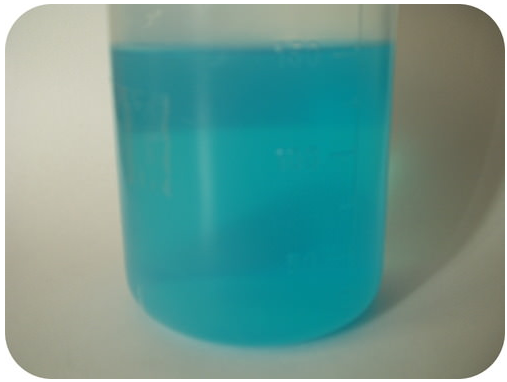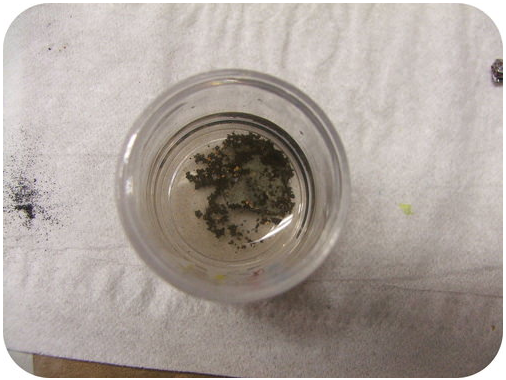23.1: Direct Redox Reactions
- Page ID
- 53967
Gold and silver are widely used metals for making jewelry. One of the reasons these metals are employed for this purpose is that they are very unreactive. They do not react in contact with most other metals, so they are more likely to stay in tact under challenging conditions. No one wants their favorite piece of jewelry to fall apart!
Direct Redox Reactions
When a strip of zinc metal is placed into a blue solution of copper (II) sulfate (figure below), a reaction immediately begins as the zinc strip begins to darken. If left in the solution for a longer period of time, the zinc will gradually decay due to oxidation to zinc ions. At the same time, the copper (II) ions from the solution are reduced to copper metal (see second figure below), which causes the blue copper (II) sulfate solution to become colorless.


The process that occurs in this redox reaction is shown below as two separate half-reactions, which can then be combined into the full redox reaction.
\[\begin{array}{ll} \text{Oxidation:} & \ce{Zn} \left( s \right) \rightarrow \ce{Zn^{2+}} \left( aq \right) + 2 \ce{e^-} \\ \text{Reduction:} & \ce{Cu^{2+}} \left( aq \right) + 2 \ce{e^-} \rightarrow \ce{Cu} \left( s \right) \\ \hline \text{Full Reaction:} & \ce{Zn} \left( s \right) + \ce{Cu^{2+}} \left( aq \right) \rightarrow \ce{Zn^{2+}} \left( aq \right) + \ce{Cu} \left( s \right) \end{array}\nonumber \]
Why does this reaction occur spontaneously? The activity series is a list of elements in descending order of reactivity. An element that is higher in the activity series is capable of displacing an element that is lower on the series in a single-replacement reaction. This series also lists elements in order of ease of oxidation. The elements at the top are the easiest to oxidize, while those at the bottom are the most difficult to oxidize. The table below shows the activity series together with each element's oxidation half-reaction.
| Table \(\PageIndex{1}\): Activity Series of Metals | ||
|---|---|---|
| Element | Oxidation Half-Reaction | |
| Most active or most easily oxidized. | Lithium | \(\ce{Li} \left( s \right) \rightarrow \ce{Li^+} \left( aq \right) + \ce{e^-}\) |
| Potassium | \(\ce{K} \left( s \right) \rightarrow \ce{K^+} \left( aq \right) + \ce{e^-}\) | |
| Barium | \(\ce{Ba} \left( s \right) \rightarrow \ce{Ba^{2+}} \left( aq \right) + 2 \ce{e^-}\) | |
| Calcium | \(\ce{Ca} \left( s \right) \rightarrow \ce{Ca^{2+}} \left( aq \right) + 2 \ce{e^-}\) | |
| Sodium | \(\ce{Na} \left( s \right) \rightarrow \ce{Na^+} \left( aq \right) + \ce{e^-}\) | |
| Magnesium | \(\ce{Mg} \left( s \right) \rightarrow \ce{Mg^{2+}} \left( aq \right) + 2 \ce{e^-}\) | |
| Aluminum | \(\ce{Al} \left( s \right) \rightarrow \ce{Al^{3+}} \left( aq \right) + 3 \ce{e^-}\) | |
| Zinc | \(\ce{Zn} \left( s \right) \rightarrow \ce{Zn^{2+}} \left( aq \right) + 2 \ce{e^-}\) | |
| Iron | \(\ce{Fe} \left( s \right) \rightarrow \ce{Fe^{2+}} \left( aq \right) + 2 \ce{e^-}\) | |
| Nickel | \(\ce{Ni} \left( s \right) \rightarrow \ce{Ni^{2+}} \left( aq \right) + 2 \ce{e^-}\) | |
| Tin | \(\ce{Sn} \left( s \right) \rightarrow \ce{Sn^{2+}} \left( aq \right) + 2 \ce{e^-}\) | |
| Lead | \(\ce{Pb} \left( s \right) \rightarrow \ce{Pb^{2+}} \left( aq \right) + 2 \ce{e^-}\) | |
| Hydrogen | \(\ce{H_2} \left( g \right) \rightarrow 2 \ce{H^+} \left( aq \right) + 2 \ce{e^-}\) | |
| Copper | \(\ce{Cu} \left( s \right) \rightarrow \ce{Cu^{2+}} \left( aq \right) + 2 \ce{e^-}\) | |
| Mercury | \(\ce{Hg} \left( l \right) \rightarrow \ce{Hg^{2+}} \left( aq \right) + 2 \ce{e^-}\) | |
| Silver | \(\ce{Ag} \left( s \right) \rightarrow \ce{Ag^+} \left( aq \right) + \ce{e^-}\) | |
| Platinum | \(\ce{Pt} \left( s \right) \rightarrow \ce{Pt^{2+}} \left( aq \right) + 2 \ce{e^-}\) | |
| Least active or most difficult to oxidize. | Gold | \(\ce{Au} \left( s \right) \rightarrow \ce{Au^{3+}} \left( aq \right) + 3 \ce{e^-}\) |
Notice that zinc is listed above copper on the activity series. which means that zinc is more easily oxidized than copper. That is why copper (II) ions can act as an oxidizing agent when put into contact with zinc metal. Ions of any metal that is below zinc, such as lead or silver, would oxidize the zinc in a similar reaction. These types of reactions are called direct redox reactions because the electrons flow directly from the atoms of one metal to the cations of the other metal. However, no reaction will occur if a strip of copper metal is placed into a solution of zinc ions, because the zinc ions are not able to oxidize the copper. In other words, such a reaction is nonspontaneous.
Summary
- The activity series of metals is given.
- Parameters for spontaneous reactions between metals are described.

